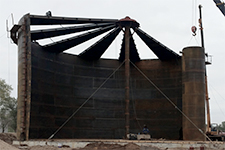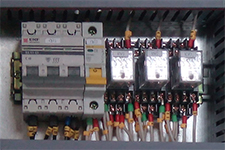THE RANGE OF SERVICES
Oil and gas facility design, equipment production, installation and construction work
THE RANGE OF SERVICES
Oil and gas facility design, equipment production, installation and construction work
OBJECTIVE
Storage, refinery operations, oil transfer
CERTIFICATION
SP 62.13330.2011
ТР ТС 032/2013
ISO 9001:2015
Oil and gas facilities are made as a complex of installations and devices providing oil intake, storage, handling and transportation. The facilities may be operated with petrochemicals, diesel, fuel oil, fuel and lubricant materials, bitumen and others. Among such facilities petroleum-storage depot, tank fields and transshipment terminal can be listed.
Depending on the tasks performed, oil depots and storage facilities are divided into several types:
If necessary, petroleum-storage depots can execute oil conditioning for transport and storage, f.e. petroleum product refining, oil degassing, oil dehydration, oil heating and temperature maintenance. Oil separation, degassing and dehydration are performed by a special effluent treatment facilities such as gas-oil separation plants, fiberglass oil catchers, separator water boots, clarifier tanks, filter units and other.
The core of facilities is vertical and horizontal tanks. The storage capacity depends upon facility location:
Oil storage tanks have different design factors:
If tanks and vessels are operated in cold climate or with viscous oil heat insulation (blanket type thermal insulation) and heating system are used.
In addition to tanks and vessels there are other oil storage and production facilities:
| Unit | Objectives | Equipment |
|---|---|---|
| Railway jobs zone | Oil intake and oil-by-rail shipment | Tank car loading/unloading rack, operator's shack, pump plant, approach lines |
| Marine operations area | Oil intake, offshore loading system and offshore oil delivery | Oil jetty, shore tanks, pump plant, oil-pipe lines, operator's shack |
| Storage area | Oil storage | Tank fields, oil-pipe lines, operator's shack |
| Allowable zone | Oil loading | Loading/unloading rack, warehouse for storage, quality control laboratory etc. |
| Support facilities | Maintenance of equipment | Boiler-house, maintenance shop and warehouse, Utilities, Infrastructure and Offsites |
| Management | Petroleum storage facilities management and control | Security post, headquarters, fire station with required facilities etc. |
| Petroleum refining area | Oil-refining, degassing and dehydration | Gas-oil separator, dehydration tanks, oil catchers, treating facilities, pumping stations, oil filters etc. |
Proper equipment layout allows to organize a clear and stable technological processes, which eliminate the risk of incorrect workflow. Uninterrupted operation and orchestrated actions allows to achieve maximum efficiency and avoid uncontrolled and unwanted time expenditures.
The main production goal of petroleum-storage depot, tank fields is oil intake, storage, handling, treatment and transfer.
Oil storing is carried out in steel tanks which are intended for the petroleum products with the following characteristics: density - up to 1600 kg/m3, excess pressure - up to 5 kPa, gas space discharge – up to 0,5 kPa, the maximum wall temperature - +160°C, the maximum media temperature - + 90°C, media temperature should be lower closed-cup flash point by at least 35°C.
Another goal is oil transfer, which is the process of oil transportation between several means of transport. Petroleum product via nozzle is derived from the tank and goes down the pipeline where custody transfer metering station is installed, pumping equipment and dispensing equipment. The pipelines are equipped with shut-off and relief valves that provide fluid flow regulation.
When petroleum products storing and transfer, breathing and filling loss occur. Tank breathing is the loss through the pressure vent valves resulting from temperature fluctuations and absolute pressure changes. The volume of losses depends on gas space capacity and design overpressure. Filling loss results from loading-unloading operations, which lead to gas vapour mixture driving-out. For example, when filling the tank with gasoline about 0.55 kg/m3 will be lost in the summer and about 0.35 kg/m3 in the winter. While emptying of tank, losses can be approximately 0.1 kg/m3.
WORK STAGES PERFORMED








Oil and gas facilities installation includes pre-construction activities and construction-assembly works. List of works depends on the equipment and facility specifics. Standard activities conducted in field are listed in the table below.
| Works | Light oils: gasoline, diesel, jet fuel etc. | Heavy petroleum products: oil fuel, lube oil, bitumen, tar etc. |
|---|---|---|
| Tank foundation arrangement | + | + |
| Vehicle loading/unloading rack erection | + | + |
| Crude oil rail loading erection | if applicable | if applicable |
| Pumping station installing | + | bitumen and oil fuel |
| Internal floating roof assembling | + | if applicable |
| Tank heating system assembling | - | + |
Work performance is carried out taking into account the facility earth information, climatic data, local topography and geology of the area. Fire and explosion hazard management and environment preservation are also taken into account.
Equipment manufacturing, petroleum-storage depots and refinery tankage design, installation and construction works at site are executed by the SINTEZ Group specialists in accordance with the industrial standards. The main of them are as follow:
Adherence to state standards guarantees safe operation of the facility and failure-free service of the equipment throughout working life.
Cost calculation and work schedules are made by specialists of OOO Neftegazengineering taking into account the remoteness of the facility, operating conditions, number and size of the needed tanks, equipment configuration and layout etc.